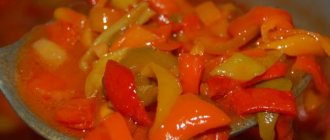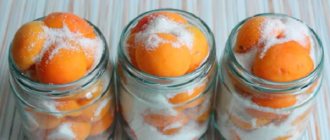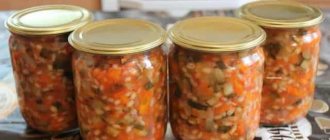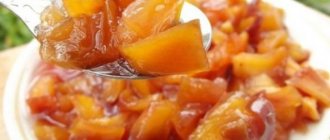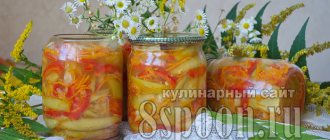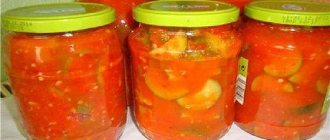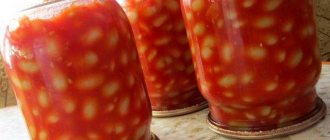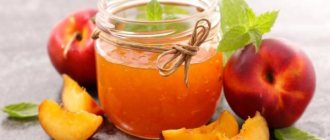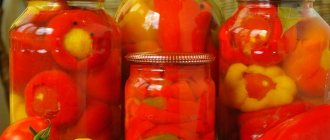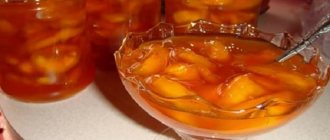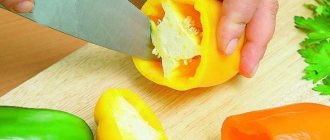LiveInternetLiveInternet
-Music
—Categories
- Recipes (6762)
- Architecture (16)
- Aphorisms, quotes (54)
- Great and other posts (16)
- Knitting (259)
- Knitting by machine (11)
- Cities and countries, customs and traditions (37)
- Horoscopes, magic, fortune telling, predictions (55)
- DIY decor (71)
- Diets (40)
- For the dacha (for the garden, vegetable garden) (55)
- For home (90)
- furniture (10)
- little things (39)
- comfort (28)
- Celebrities, historical figures (183)
- Interesting (112)
- Interiors (94)
- For Valentine's Day (5)
- For the New Year (57)
- For Easter (27)
- For Christmas (9)
- Dolls (134)
- Makeup, hairstyles (70)
- Fashion, couturier (52)
- Music (63)
- Traditional medicine (75)
- Nature, animals (18)
- Funny (27)
- Tests and test results (34)
- Self-care (96)
- Artists (92)
- Sewing (51)
—Search by diary
—Subscription by e-mail
-Statistics
Canned peaches in halves for the winter
Photo of canned peaches in halves for the winter
You can make canned peaches in halves not only with sugar, but also with honey. The recipe below is sweet and has a pleasant rum flavor.
- Peeled peaches – 3 kg;
- Peach kernels - about 10 pieces;
- Sugar – 750 g;
- Honey – 250 g;
- Rum;
- Water – 1 l.
- Peaches cut in half are placed in jars.
- Water with sugar and honey are boiled in a saucepan. When the syrup boils, turn it off and allow to cool. Only after this they are poured with peaches in jars.
- In addition to the syrup, 2 tablespoons of rum are poured into each jar, and 1-3 kernels of seeds, peeled from hard skin, are placed.
- Preservation is sterilized and sealed with lids that have been boiled in advance.
Canned peaches are a delicacy for children and adults. They can be eaten throughout the year, but they taste best, of course, in winter, when there is a shortage of fresh fruit. When making such a dish, it is worth remembering that peaches themselves are low-calorie, but due to the abundance of sugar in recipes, ready-made meals for people with diabetes or on diets are not recommended. Although if you replace sugar with fructose, then in small quantities and with the permission of your doctor, you can eat dessert.
- Peaches cut in half are placed in jars.
Canned peaches for the winter
Thursday, July 30, 2020
Replenish your collection of homemade preparations for the winter - write down a recipe for canned peaches in syrup. The result will be a delicious delicacy, and much healthier than a store-bought product.
Peaches, canned in halves and peeled, will not only be an excellent independent dessert, but also the basis for preparing many sweet home-cooked dishes. These canned peaches go well with any type of dough - pies with this homemade preparation for the winter will pleasantly surprise you with their taste.
To ensure that this simple preparation for the winter does not disappoint you, always choose the best fruits: peaches should be firm, preferably even slightly unripe, without damage. From the specified amount of products I get 3 cans of canned peaches for the winter: 2 pieces of 1 liter and one 0.85 liter.
Canned whole peaches
Photo of whole canned peaches
When rolling up whole peaches, you need to remember that such preservation is eaten first, within 1 year. Then the peaches spoil and become unsuitable for food.
Ingredients (for two 3-liter jars):
- Peaches – about 30 pieces;
- Sugar – 1 kg;
- Water – 5 l.
- Remove fruits from stems and leaves and wash thoroughly. You can leave the peel, but it is better to remove it. On some varieties of peaches the skin comes off easily, on others it is difficult. If she doesn't want to move away, you can cut her off with a sharp knife. The second option is to put the peaches in boiling water for a while. The skin will then come off on its own.
- The jars are sterilized and dried, and then filled with prepared fruit.
- A syrup is made from water and sugar in a saucepan. When it boils, pour it over the fruits, and after 5 minutes pour it back into the pan and bring it to a boil again.
- When the syrup is boiled again, it is poured into jars and rolled up. Boiled lids are used for rolling.
Cooking step by step:
The recipe for canned peaches in syrup includes the following ingredients: fresh selected peaches, water, granulated sugar and citric acid.
First of all, wash the fruits under cold running water and wipe them dry with a towel.
Then use a sharp knife to cut each peach along the pit. Now we take the fruit in our hands and with both palms we gradually scroll the halves in different directions. This is the most gentle way to minimize damage to the pulp. So, peaches split into 2 halves: empty and with a pit. Carefully cut out the bones with a sharp knife. And only now can you thinly remove the skin with a knife.
Place the prepared peach halves into pre-sterilized jars. I do this in the microwave. I wash the jars, pour about 100 ml of cold water each and boil at the highest power. Depending on the volume of the jars, the time may be needed differently: for example, 4 minutes will be enough for a half-liter jar. Place the halves tightly, but do not press them too hard so that the peaches retain their shape.
Now bring the water to a boil in a saucepan and pour boiling water over the peaches in the jars. Cover with lids (they must first be boiled for 5 minutes) and leave for 20 minutes.
Useful tips
Peach preparations turn out very tasty if high-quality fruits are chosen for this. There are several recommendations for preparation:
- It is important to follow the proportions indicated in the recipe.
- It is advisable to harvest the fruits without seeds, as this way they will last longer.
- In order for products to be preserved for a long time, it is necessary to perform high-quality preparation of products and containers.
You can twist the peaches yourself, as there is nothing complicated about it. All the recipes presented below allow you to create delicious dishes.
The sweetness of fruits is determined by their aroma. If the smell is rich, then the peaches will be sweet and juicy. It is important that there are no extraneous aromas.
Peaches must be selected according to the following criteria:
- Elasticity and velvety are considered evidence of ripeness.
- The skin of the fruit should be smooth.
- Requires natural skin color.
- The pulp of the fruit is yellow, white, with pinkish veins.
Flat peaches are not as juicy as classic ones. It is advisable to take the fruits by weight. You should not choose hard or soft products, as well as those with green, dark spots. Wrinkled fruits are also not suitable. Before creating blanks, they must be thoroughly washed.
For peaches in syrup, it is better to choose 1-liter jars. You need to take only high-quality containers, which should be thoroughly washed with baking soda and then rinsed. Then the preparations will be preserved for a long time.
After this, the jars should be sterilized. An effective and simple method is steam cleaning. You need to boil water in a saucepan. A grate is installed on top, onto which the inverted containers are fixed. They are boiled for about 30 minutes. Then the container is left on a towel.
At the height of the season, when such delicious and beloved nectarines or peaches are ripening, you can think about preparing for the winter. Everyone wants the delicacy to be as tasty, tender, and aromatic as possible. That is, to make it special.
The advice of experienced chefs will help here. For example, to add a little color or flavor to compote, you can put several berries of any kind in each jar. Cherries, currants, strawberries or raspberries are suitable for this. In addition, the berries will add sourness to the compote, and in this case citric acid will not be needed.
If you want the fruit to end up tender, you will need to remove the skin. To do this, you need to slightly cut the nectarine on top in a cross-shaped manner, and throw each of them into boiling water for 2-3 minutes. This process is called blanching. After which the nectarines must be immediately immersed in cold water and the skins removed.
To speed up the process a little, and also to avoid burning your hands, you can do this using a colander. However, you should not put more than 5 nectarines in it, so that they do not interfere with each other and are cooked equally. The water after this process will be aromatic, and in order not to waste it, you can pour it over the prepared nectarines. It will turn out very tasty.
If you want to slightly dilute the sweetness of nectarines, and also give the dish some zest, you can add a few slices of lemon to the compote or simply squeeze the juice out of them. However, if the nectarines are not ripe, then you should not do this.
If these fruits are sealed with a pit, then they should not be stored for more than 1 year. Indeed, in this case, the hydrocyanic acid, which is in the seeds, can pass into the pulp and ruin the dish. Therefore, it is better to either use such fruits immediately or seal them without seeds.
We invite you to familiarize yourself with Pumpkin juice in a juicer - a delicious vitamin drink. How to make pumpkin juice in a juicer. Apple and pumpkin juice in a juicer for the winter
Harvesting nectarines is an interesting and enjoyable process. It is worth paying attention to while the nectarines have not yet departed. Then you can add your favorite fruits to your diet for at least a whole year.
You will learn how to properly peel the fruit in the following video.
- For jam, it is important to select fresh, firm and unripe fruits so that during the cooking process they do not boil down and turn into puree.
- It is better to prepare the delicacy in a low stainless steel pan. This type of cookware does not react with food during cooking, even at high temperatures. Therefore, it does not destroy the beneficial properties contained in fruits.
- The jam must be cooked slowly to prevent it from burning and running away.
- It is advisable to cook the fruits in small portions, no more than 2 kg, since large quantities require long-term cooking, and this invariably leads to a loss of quality.
- The readiness of the jam is determined in the following way: drop a drop of cooled syrup onto a clean saucer; if it does not spread, then the jam is ready.
- Jars and lids must be sterilized and dry, since a drop of water is enough for the jam to mold or ferment.
Read more: how to properly sterilize jars and lids - The finished jam can be poured into jars hot or cold, depending on the preparation method.
The hot method is used for jam - five minutes. The dessert is placed hot in sterilized jars and immediately rolled up with lids, turned upside down and put away to cool under a blanket.
If the jam has been cooked for a long time or has been subjected to repeated cooking, then it does not require seaming. When completely cooled, the jam is placed in dry, sterilized jars and covered with nylon or metal screw-on lids.
Benefits of Nectarine
- helps improve the condition of the skin;
- maintains visual acuity;
- strengthens the immune system;
- is an antioxidant;
- prevents the development of cancer;
- improves the nervous system;
- heals cartilage tissue;
- prevents the occurrence of thrombosis;
- increases stress resistance.
Nectarine contains:
It is important that nectarine does not lose more than half of its beneficial qualities even after heat treatment. This makes it an even more valuable product.
How to cook melon in syrup for the winter
To the “basic” recipe for melon in syrup for the winter in jars, you can add almost any fruit, as well as nuts and spices. In most cases, the finished dessert only benefits from this; the taste acquires original notes.
Recipes for melon in syrup for the winter without sterilization
Ingredients required for the "basic" recipe:
- melon pulp – 1 kg;
- granulated sugar – 250 g;
- citric acid - to taste (usually 2-3 pinches are enough);
- drinking water.
The dessert is prepared like this:
- Fill the jars with chopped melon pulp. They are laid quite tightly, but not compacted, leaving space for the syrup.
- Boil water, pour into jars, let stand for 8-10 minutes, covering with lids.
- Pour the water back into the pan, add citric acid and sugar. Boil the syrup, heating the liquid until the crystals are completely dissolved.
- Pour the syrup into jars and close the lids.
Important! The volume of water is not indicated in this recipe; it all depends on the density of the melon. On average, a liter jar takes 250-300 ml.
Recipe for melon with zucchini in syrup for the winter
The pieces are very similar in appearance and taste to canned pineapples. Required ingredients:
- melon pulp – 500 g;
- zucchini pulp – 500 g;
- granulated sugar – 1 kg;
- drinking water – 1 l.
Preparing melon in sugar syrup for the winter with zucchini:
- Heat water and sugar to prepare syrup.
- Throw the melon and zucchini into the liquid.
- Bring to a boil, cook over low heat for about half an hour.
- Place the pieces into jars. Pour in the syrup in which they were boiled and close with lids.
Important! In this recipe, zucchini is prepared in the same way as melon - washed, cored, peeled, and pulp cut into small cubes.
Melon in syrup with citric acid and spices
To prepare the dessert you will need:
- melon pulp – 1 kg;
- granulated sugar – 300 g;
- drinking water – 1 l;
- citric acid – 5 g;
- natural vanilla – 1 pod;
- cinnamon – 1 stick;
- cloves – 8-10 pcs.;
- anise – 8-10 pcs.
Step-by-step instruction:
- Pour sugar and citric acid into the water. Tie other spices into a gauze “bag” and place them in a container.
- Bring the liquid to a boil. Let the syrup brew for 4-5 hours.
- Fill the prepared jars with sliced melon pieces.
- Boil the syrup again and pour the liquid into the jars. Close with lids.
Important! The syrup from this recipe is very suitable for soaking biscuits. And the fruit itself is recommended to be added to ice cream and cocktails.
Preparing for the winter with nectarines and grapes
Ingredients needed for this recipe:
- melon pulp – 800 g;
- seedless grapes – 500 g;
- nectarine pulp – 500 g;
- granulated sugar – 500 g;
- drinking water – 2 l;
- citric acid - optional (you can omit it at all, usually 1/3 tsp is enough).
How to prepare dessert:
- Remove the stems from the grapes and remove the seeds from the nectarines. There is no need to peel it.
- Place fruit in jars in layers - melon, nectarines, grapes.
- Boil syrup from water with sugar, adding citric acid if desired.
- Pour the resulting liquid into jars and close the lids.
Important! According to this recipe, you can prepare a dessert with grapes and whole nectarines, but then they are placed in jars first and poured with boiling water. Then, after 7-10 minutes, drain the liquid, lay out other fruits, and pour in syrup.
Melon in syrup with pears
What you will need for this homemade preparation:
- melon pulp – 1 kg;
- pear pulp – 500 g;
- granulated sugar – 500 g;
- drinking water – 2 l;
- citric acid - a pinch.
How to cook:
- Place the pieces into jars. You must first remove the core and stem from the pear. The skin can be peeled off as desired.
- Boil syrup from water with sugar and citric acid, pour it over the fruit, and cover with lids.
Important! This homemade preparation is an excellent addition to porridge.
Melon in syrup with figs
The flavor combination is unexpected, but will not disappoint anyone. What you will need:
- melon pulp – 1.5 kg;
- figs – 200 g (3-4 pcs.);
- granulated sugar – 250 g;
- drinking water – 750 ml;
- citric acid – 1 tsp.
Prepare dessert with figs like this:
- Bring water with sugar to a boil. Add citric acid and stir. Allow the syrup to cool to body temperature.
- Wash the figs and cut them into quarters, place them in jars along with the melon pulp. Pour syrup over fruit.
- Place a towel and a cloth napkin on the bottom of a large saucepan and place the jars there so that they do not touch each other. Cover with lids. Pour warm water into a container up to the shoulders of the jars.
- Bring water to a boil, sterilize for 12-15 minutes. Close the workpiece with lids.
Important! One serving according to the recipe is designed for two jars of 700-800 ml.
Melon in sugar syrup with added ginger
A very unusual dessert with a spicy-sweet taste will require the following ingredients:
- melon pulp – 1 kg;
- ginger root – 120-150 g;
- granulated sugar – 500 g;
- citric acid – 1 tsp;
- drinking water – 2 l.
How to make dessert with ginger:
- Peel the ginger root and cut into thin slices. Place 2-3 pieces in the bottom of each jar. Fill the remaining volume with melon cubes.
- Boil water and pour it into jars. After 8-10 minutes, pour into the pan.
- Add sugar and citric acid, bring to a boil.
- Pour syrup over melon and ginger in jars and close with lids.
Important! You can eat melon in syrup with ginger only 1.5-2 months after the jars are closed.
Canning nectarines
Nectarines in their own juice are even tastier than fresh fruits. The delicacy can be stored all winter. After opening the jar, the delicious aroma spreads throughout the apartment.
- 550 g nectarines;
- 350 g granulated sugar;
- 1 l. water.
You will also need jars with lids and a container for boiling fruit.
- Rinse the fruits thoroughly.
- Cut nectarines in half, remove seeds.
- Place the fruit in a large saucepan or metal bowl. Cover them with granulated sugar. Leave for 1 hour at room temperature.
- Pour cold water over nectarines. Heat the future delicacy over low heat until the first bubbles begin to boil. In this case, you cannot mix the fruits. You can only carefully move them from the bottom of the container to the surface using a wooden spatula.
- Thoroughly sterilize jars and lids.
- When the nectarines have cooled, they must be brought to the first bubbles again.
- Place the fruits in jars and fill them with syrup.
- Place the rolled up jars with their lids down and wrap them in a blanket. Leave the workpieces in this position for 24 hours.
Canned nectarines can be used as a filling for pies, cake decorations, and a component of jelly, unless, of course, the pastry chef eats the most delicate fruits immediately.
Canned nectarines will be ready in 1 month. During this time, they will be saturated with syrup, become tender, aromatic, and will not lose their usual shape.
Note! If you want to achieve a more refined taste, you can put one fresh mint leaf, pre-treated with boiling water, in a jar. This version of the preparation will have a light, minty aftertaste with a subtle bitterness.
You will also need jars with lids and a container for boiling fruit.
Canned nectarines for the winter. How to preserve nectarines
There are many classic recipes for winter preparations. Strawberry compotes, currant jam, apple jams become boring over time. I want something more exotic. Canned nectarines are a win-win option. Everyone will love this dessert!
Choose your recipe
What are the benefits of nectarine?
Nectarine is a mysterious fruit. Some consider it an independent fruit. Others are convinced that this is a modified variety of peach, or a relative of the apricot. But everyone agrees on one thing - this is a very valuable fruit. The vitamins contained in it have a beneficial effect on the human body. Nectarine is especially useful for children, pregnant women and the elderly.
Benefits of Nectarine
- helps improve the condition of the skin;
- maintains visual acuity;
- strengthens the immune system;
- is an antioxidant;
- prevents the development of cancer;
- improves the nervous system;
- heals cartilage tissue;
- prevents the occurrence of thrombosis;
- increases stress resistance.
Nectarine contains:
- calcium,
- magnesium,
- phosphorus,
- iron.
- zinc.
It is important that nectarine does not lose more than half of its beneficial qualities even after heat treatment. This makes it an even more valuable product.
Canning nectarines
Nectarines in their own juice are even tastier than fresh fruits. The delicacy can be stored all winter. After opening the jar, the delicious aroma spreads throughout the apartment.
Preparation ingredients
- 550 g nectarines;
- 350 g granulated sugar;
- 1 l. water.
You will also need jars with lids and a container for boiling fruit.
Cooking instructions
- Rinse the fruits thoroughly.
- Cut nectarines in half, remove seeds.
- Place the fruit in a large saucepan or metal bowl. Cover them with granulated sugar. Leave for 1 hour at room temperature.
- Pour cold water over nectarines. Heat the future delicacy over low heat until the first bubbles begin to boil. In this case, you cannot mix the fruits. You can only carefully move them from the bottom of the container to the surface using a wooden spatula.
- Thoroughly sterilize jars and lids.
- When the nectarines have cooled, they must be brought to the first bubbles again.
- Place the fruits in jars and fill them with syrup.
- Place the rolled up jars with their lids down and wrap them in a blanket. Leave the workpieces in this position for 24 hours.
Canned nectarines can be used as a filling for pies, cake decorations, and a component of jelly, unless, of course, the pastry chef eats the most delicate fruits immediately.
Canned nectarines will be ready in 1 month. During this time, they will be saturated with syrup, become tender, aromatic, and will not lose their usual shape.
Note! If you want to achieve a more refined taste, you can put one fresh mint leaf, pre-treated with boiling water, in a jar. This version of the preparation will have a light, minty aftertaste with a subtle bitterness.
